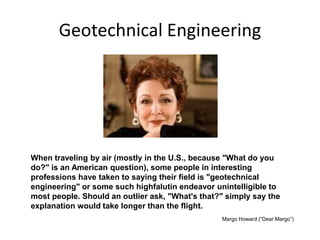Things about Geotheta
Wiki Article
Getting My Geotheta To Work
Table of ContentsThe Basic Principles Of Geotheta The Ultimate Guide To GeothetaIndicators on Geotheta You Should Know5 Easy Facts About Geotheta Explained
They team up with civil designers, structural engineers, architects, and other specialists to incorporate geotechnical considerations into the total job layout and construction procedure. This requires effective team effort, control, and communication to ensure that the geotechnical facets align with the task objectives and satisfy regulative requirements.Mining & Products Engineering: Concepts of drilling, penetration rates, and factors influencing the selection of boring approach. Blowing up techniques in surface and below ground operations. Mechanical and continual techniques to fragmentation, including longwall shearing and fullface boring.
Integrated analysis of fragmentation and comminution operations. Offered by: Mining & Materials Design.
An Unbiased View of Geotheta
Bachelor's level programs in civil, geotechnical, geological, and ecological design generally last 4 years and include basic education and learning training courses in English, social science, and the liberal arts, as well as programs in innovative maths, architectural geology, and fluid mineralogy. (https://hearthis.at/geotheta/set/geotheta/)Geotechnical design includes the evaluation of the dirt and rock problems at a particular website, and their implications for the development of that website. As most structures depend on the ground for assistance, it lacks surprise that a comprehensive understanding of the ground conditions, and the viability of structure systems, are essential to the lasting stability and efficiency of the building or structure.
Being experts in the investigation of geological formations and ground practices, geotechnical engineers execute clinical examinations and testing to recognize the influence these geological developments may carry the layout and building of building, civil and infrastructure jobs. This competence is vital for the design and building of structures, roadways, tunnels, dams, bridges, and water system and sewage systems.
The geotechnical group at Douglas Allies routinely consult with designers, style designers, developers, and builders to make suggestions on style and growth proposals to guarantee that the developed structures are appropriately designed for the ground problems. For instance, the style of footing systems needs to take into consideration the weight of the structure, the ability of the ground to support that weight together with activity tolerances and effective building and construction.
10 Easy Facts About Geotheta Explained
This job is considerably simplified by the usage of our Douglas Map geospatial platform that makes this details readily accessible in an easy to make use of web internet browser user interface. A geotechnical engineer will certainly route the exploration of boreholes and test pits to accumulate dirt and other examples, and likewise analyze surface attributes and ground direct exposures to create a geotechnical design of the subsurface conditions.Depending on the job type and ground problems ran into, lab testing might amongst various other things analyze toughness, compressibility, reactivity and/or permeability of dirt and rock samples. After this information is collected and collected, the results are made use of for a geotechnical version of the website, which is generally offered as areas across the website.

A geotechnical investigation by nature can only examine the ground problems at the places drilled or dug deep into. All-natural variants in soil and rock problems can happen across a site and between test locations. It is for that reason good technique that the geotechnical designer be kept throughout building and construction of the task to provide on-site confirmation that the ground conditions run into follow the assumptions and advice provided in the geotechnical examination record.
10 Easy Facts About Geotheta Described
Geotechnical designers use their thorough knowledge of dirt and rock to assess threat and address troubles on varied framework projectsGeotechnical engineering is a specialist branch of civil engineering which takes a look at the behaviour of earth products and the application of soil and rock technicians. Geo Tech Engineering. As a geotechnical designer, you will assess the physical, mechanical and chemical properties of soil and rock in order to make foundations, keeping frameworks and earthworksGeotechnical engineering is closely connected to and overlaps with, both engineering geology and ground engineering - https://www.intensedebate.com/people/geotheta. It's feasible to be experts in geotechnics or benefit a geotechnical company but be referred to as an engineering rock hound or a ground designer. As a geotechnical designer, you'll require to: construct and preserve connections with clients and other professionals associated with the site, throughout each projectmaintain security standards on site bear in mind price effects when you make recommendationsstudy geological maps and airborne photographs from a series of sources and from various time periodsexamine construction plans to see how practical they are based on your understanding of the siteinvestigate risks or geological threats for the sitesearch for ecologically delicate functions, such as garbage dump start to establish valid and expository ground modelsplan area investigationsdrill and evaluate examples of bedrock, dirt, groundwater and additional materials manage other specialists on sitesolve technical issues as they arise, such as unexpected frameworks at drill sitesmonitor conditions throughout and after building and construction to ensure structures are stable in the short and long termadding information accumulated on website to your preliminary researchcreating geotechnical computations, drawings, and 2 or three-dimensional computer system versions interpreting the datamaking recommendations regarding the proposed use of the site

Report this wiki page